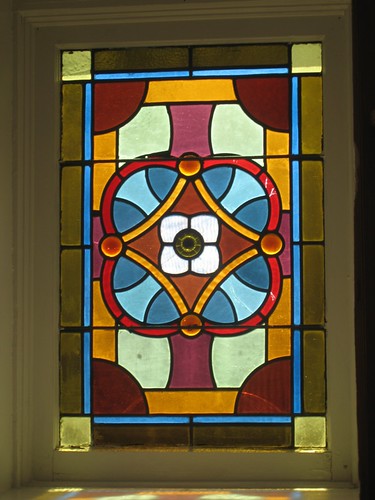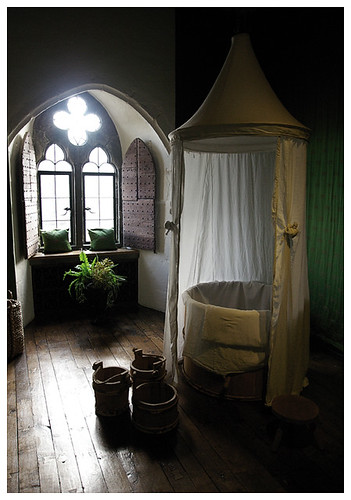 It's perhaps not a surprise that I'm a little obsessed with medieval stuff. If I could, I'd probably live in a castle, cold stone floors, drafty garderobes, and all. I blame all the King Arthur stories I grew up on (and my own not-so-secret desire to be King Arthur (well, the early King Arthur, before all the sad stuff happened).
It's perhaps not a surprise that I'm a little obsessed with medieval stuff. If I could, I'd probably live in a castle, cold stone floors, drafty garderobes, and all. I blame all the King Arthur stories I grew up on (and my own not-so-secret desire to be King Arthur (well, the early King Arthur, before all the sad stuff happened).So one of the things I love about our house is this original window in the second floor library -- it has a very medieval flavor to me. The rest of our Queen Anne house has something of an Eastlake flavor -- simplified geometric patterns -- which I think melds reasonably well with Gothic / medieval motifs. (For example, most of our doors have gorgeous Eastlake hinges, and take a look at this cool Eastlake Gothic settee.) The Victorians were often in love with the Gothic -- it came back over and over in their era (Gothic Revival, aka Neo-Gothic). So I don't think it'd be too historically anachronistic to incorporate a bit more Gothic in my house.
I don't want to live in a house that looks like a Renaissance Faire, but if I can incorporate some medieval elements simply and beautifully -- well, it's very tempting. The stained glass piece I'm working on for the dining room is explicitly Gothic, a central rose surmounted by three Gothic points, in mostly blue-green-purple tones (deep in the center, pales at the edges, with a ruby center). I'll scan the image in for you when I get a chance -- it's at the studio right now. So obviously, I can bring in the medieval with glass.
Another place to do that is with doors. I love this image, of a powder room door:


Still, if we can keep the restraint, maybe it'll work. We're going to have a lot of bookshelves in that room; we're thinking maybe they could have subtle Gothic tops to them? Like this:




(I should note, I haven't actually discussed all this with Kevin yet. :-) But he does read a lot of fantasy novels too...)

Interesting: to my uneducated eye, that bookcase top looks more South Asian than Gothic.
And that pointed shower-arch looks more Islamic to me.
But I know pretty much nothing about this stuff.
I love the cloverleaf-pattern window in that last picture.
I think the Moroccan stuff has a similar look to the more relaxed Gothic stuff.
The cloverleaf pattern is called a quatrefoil. I am very fond of them too. http://en.wikipedia.org/wiki/Quatrefoil
I think pretty much any pointed arch is usually called Gothic and any rounded arch is usually called Roman, although the Roman arch was actually stolen from the Etruscans.